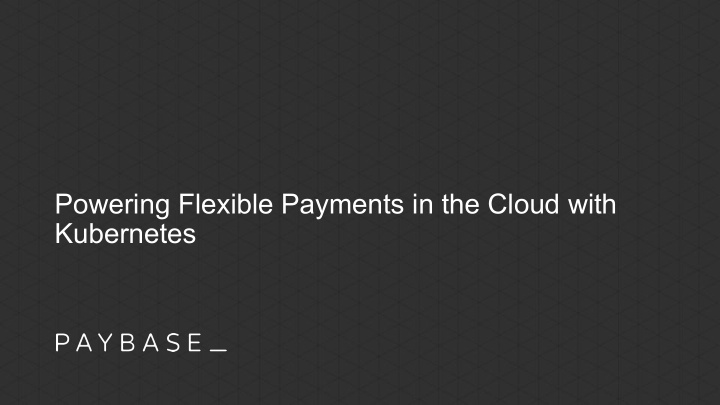



Powering Flexible Payments in the Cloud with Kubernetes
whoami Ana Calin Systems Engineer @Paybase Twitter: @AnaMariaCalin 3
01 whoami 02 About Paybase 03 Things we’ve achieved so far 04 Our tech stack Table of Contents 05 Anatomy of a compromise 06 A few notes on security and resilience 07 Challenges we’ve encountered 08 Challenges we’ve circumvented 09 Summary 4
> API driven Payments Provider Platform > B2B - marketplace, gig/sharing economies, cryptocurrency > We make regulation easier for our customers
Things we’ve achieved so far ✓ We are ~ 2 years old ✓ Built our own processing platform from scratch ✓ We are currently onboarding our first 7 clients ✓ FCA authorised ✓ We have an EMI license ✓ Innovate UK grant worth £700k ✓ PCI DSS (The Payment Card Industry Data Security Standard) Level 1 compliant 6
Some of our tech stack 7
Anatomy of a compromise 8
Details about the compromise ✓ in the scope of an internal infrastructure penetration test ✓ in our production cluster ✓ pen tester had access to a privileged container 9
The weak link : GKE ● Compute engine scope Compute engine ● default service account ● Legacy metadata endpoints 10
Metadata endpoints 11
Mitigations OR 12
Result 13
The weak link : Tiller ● comes with mTLS disabled is able to create any ● K8S API resource in a cluster performs no ● authentication by default 14
Tiller 15
Mitigations RESULTS IN 16
Security and resilience 17
A secure K8S cluster should ● use a dedicated SA with minimal permissions ● use minimal scopes - least privilege principle use Network Policies or Istio with authorization rules set up ● use Pod Security Policies ● ● use scanned images ● have RBAC enabled 18
A resilient Kubernetes cluster should ● be architected with failure and elasticity in mind by default ● have a stable observability stack be tested with a tool such as Chaos Engineering ● 19
Challenges we’ve encountered on our road to compliance 20
Challenge 1: The What As a PCI compliant PSP with many types of dbs , I am want to be able to query data-sets in a secure and db agnostic manner so that engineers and customers can use it easily and we are not prone to injections . (req. 6.5.1) 21
Challenge 1: The How Meet PQL 01 Inspired by SQL 02 Injection resistant 03 Used for querying data-sets 04 Database agnostic 05 Adheres to logical operator precedence 22
Challenge 1: The How 01 Lexical analysis (tokenize input) 02 Syntactical analysis (parse tokenized input to AST) 03 Abstract Syntax Tree to specific database query 23
Challenge 2: The What As a PCI compliant PSP , I am required to implement only one primary function per server to prevent functions that require different security levels from coexisting on the same server . (req. 2.2.1) 24
Challenge 2: The How 01 Server = Deployable Unit 02 Network Policies 03 Pod Security Policies 04 Only using trusted and approved images 25
Challenges we’ve circumvented on our road to compliance 26
Challenge 3: The What As a PCI compliant PSP , I am required to remove all test data and accounts from system components before the system becomes active/goes into production (req.6.4.4) 27
Common way of splitting environments PAYBASE GCP ORGANIZATION PAYBASE PJT PROD STAGING QA NS NS NS GKE GCR - IMAGE GCS - TF GCS - REPO STATE BACKUPS VPC A CDE 28
Paybase’s way of splitting environments PAYBASE GCP ORGANIZATION PROD PJT QA PJT STAGING PJT GKE GKE GKE CDE VPC A VPC B VPC C GCR GCS GCS TF STATE PJT BACKUPS PJT IMAGE REPO PJT VPC D VPC E VPC F 29
Challenge 3: Benefit 01 Security 02 Separation of concerns 03 Reduction of PCI DSS scope 04 Easier to organize RBAC 30
Challenge 3: The What As a PCI compliant PSP , I am required to remove all test data and accounts from system components before the system becomes active/goes into production (req.6.4.4) 31
Challenge 4: The What As a PCI compliant PSP , I am required to perform quarterly internal vulnerability scans,address vulnerabilities and perform rescans to verify all “high risk” vulnerabilities are resolved in accordance with the entity’s vulnerability ranking.(req.11.2.1) 32
Challenge 4: The How Image scanning 33
Here’s a diagram 34
Summary ● security is not a point in time but an ongoing journey ● you can use OSS and achieve a good level of security ● we need to challenge the PCI DSS status quo 35
Resources ✓ https://www.4armed.com/blog/hacking-kubelet-on-gke/ ✓ https://www.4armed.com/blog/kubeletmein-kubelet-hacking-too l/ ✓ https://itnext.io/how-a-naughty-docker-image-on-aks-could-giv e-an-attacker-access-to-your-azure-subscription-6d05b92bf811 36
Thank you <call to action here>
Recommend
More recommend